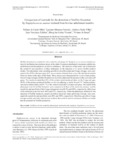Use este identificador para citar ou linkar para este item:
http://www.alice.cnptia.embrapa.br/alice/handle/doc/960427Registro completo de metadados
| Campo DC | Valor | Idioma |
|---|---|---|
| dc.contributor.author | MELO, P. de C. | pt_BR |
| dc.contributor.author | FERREIRA, L. M. | pt_BR |
| dc.contributor.author | NADER FILHO, A. | pt_BR |
| dc.contributor.author | ZAFALON, L. F. | pt_BR |
| dc.contributor.author | VICENTE, H. I. G. | pt_BR |
| dc.contributor.author | SOUZA, V. de | pt_BR |
| dc.date.accessioned | 2013-06-24T11:11:11Z | pt_BR |
| dc.date.available | 2013-06-24T11:11:11Z | pt_BR |
| dc.date.created | 2013-06-24 | pt_BR |
| dc.date.issued | 2013 | pt_BR |
| dc.identifier.citation | Brazilian Journal of Microbiology, São Paulo, v. 44, n. 1, p. 119-124, 2013. | pt_BR |
| dc.identifier.uri | http://www.alice.cnptia.embrapa.br/alice/handle/doc/960427 | pt_BR |
| dc.description | Abstract: Biofilm formation is considered to be a selective advantage for Staphylococcus aureus mastitis isolates by facilitating bacterial persistence in the udder. It requires attachment to mammary epithelium, proliferation and accumulation of cells in multilayers. The objective of this study was to determine the sensitivity and specificity of three techniques for the detection of S. aureus biofilm-positive strains. Two phenotypic tests, including growth on microtitre plates and Congo red agar, were compared with a PCR technique using 94 S. aureus strains obtained from cows with subclinical mastitis from two farms in the state of São Paulo. These strains were characterised by in vitro slime production on Congo red agar, biofilm formation on microtitre plates and the presence of the icaA and icaD genes. The results revealed that 85% of the isolates tested produced slime on the Congo red agar, 98.9% of the isolates produced biofilms in vitro by adhering to sterile 96-well "U" bottom polystyrene tissue culture plates, and 95.7% of the isolates carried the icaA and icaD genes. The results of the phenotypic tests for biofilm formation were compared with those of the molecular analysis, and the sensitivity and specificity of the Congo red agar test were 88.9% and 100%, respectively, while those of the microtitre plate test were 100% and 25%, respectively. When the phenotypic methods for the detection of biofilm producers, namely growth on microtitre plates and Congo red agar, were compared, the sensitivity and specificity were 86% and 100%, respectively. Therefore, growth on Congo red agar and the microtitre plate test are methods that could be used to determine whether an isolate has the potential for biofilm production. | pt_BR |
| dc.language.iso | por | pt_BR |
| dc.rights | openAccess | pt_BR |
| dc.subject | Mastite bovina | pt_BR |
| dc.subject | Phenotypic | pt_BR |
| dc.subject | Molecular analysis | pt_BR |
| dc.subject | Biofilms | pt_BR |
| dc.title | Comparison of methods for the detection of biofilm formation by Staphylococcus aureus isolated from bovine subclinical mastitis. | pt_BR |
| dc.type | Artigo de periódico | pt_BR |
| dc.date.updated | 2015-04-15T11:11:11Z | pt_BR |
| dc.subject.thesagro | Bovino | pt_BR |
| dc.subject.thesagro | Doença animal | pt_BR |
| dc.subject.thesagro | Mamite | pt_BR |
| dc.subject.thesagro | Staphylococcus aureus | pt_BR |
| dc.subject.thesagro | Biofilme | pt_BR |
| dc.subject.thesagro | Estirpe | pt_BR |
| dc.subject.nalthesaurus | Bovine mastitis | pt_BR |
| dc.subject.nalthesaurus | Mammary gland diseases | pt_BR |
| riaa.ainfo.id | 960427 | pt_BR |
| riaa.ainfo.lastupdate | 2015-04-15 | pt_BR |
| dc.identifier.doi | http://dx.doi.org/10.1590/S1517-83822013005000031 | pt_BR |
| dc.contributor.institution | Poliana de Castro Melo, Universidade Estadual Paulista "Júlio de Mesquita Filho" (UNESP) - Jaboticabal, SP, Brazil.; Luciano Menezes Ferreira, UNESP - Jaboticabal, SP, Brazil; Antônio Nader Filho, UNESP - Jaboticabal, SP, Brazil; LUIZ FRANCISCO ZAFALON, CPPSE; Hinig Isa Godoy Vicente, Secretaria da Agricultura do Estado de São Paulo, Jaboticabal, SP, Brazil; VIVIANE DE SOUZA, CNPC. | pt_BR |
| Aparece nas coleções: | Artigo em periódico indexado (CNPC)  | |
Arquivos associados a este item:
| Arquivo | Descrição | Tamanho | Formato | |
|---|---|---|---|---|
| APIComparisonofmethods.pdf | 439,49 kB | Adobe PDF |  Visualizar/Abrir |









